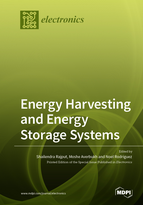Energy Harvesting and Energy Storage Systems
A special issue of Electronics (ISSN 2079-9292). This special issue belongs to the section "Power Electronics".
Deadline for manuscript submissions: closed (31 January 2022) | Viewed by 44342
Special Issue Editors
Interests: piezoelectricity; multiferroicity; energy harvesting; energy storage; photovoltaic systems; dielectrics; crystallography
Special Issues, Collections and Topics in MDPI journals
Interests: PV electrical generation; power electronics; electrical machines; vanadium redox batteries
Special Issues, Collections and Topics in MDPI journals
Interests: nanotechnology; sensors; electrical characterization; nanoelectronics; laser-induced nanomaterials; energy harvesting; energy conversion; flexible electronics; memristive devices
Special Issues, Collections and Topics in MDPI journals
Special Issue Information
Dear Colleagues,
Sustainable development systems are based on three pillars: economic development, environmental stewardship, and social equity. One of the principles set for finding the balance between these pillars is to limit the use of non-renewable energy sources. A promising method to resolve this challenge is to harvest energy from the ambient environment and convert it into electrical power. In recent days, the development of new energy generation technologies, such as solar, wind, and thermal energy, is high on demand to replace fossil fuel energy resources with cleaner renewable sources. Energy harvesting systems have emerged as a prominent research area and continue to grow at a rapid pace.
Modern technologies such as portable electronic devices, electrical transportation, communication systems, and smart medical equipment need efficient energy storage systems. Electrical energy storage devices are also used for smart grid control, grid stability, and peak-power saving, as well as for frequency and voltage regulation. Electricity generated from renewable sources (e.g., solar power, wind energy) can hardly deliver an immediate response to demand because of fluctuating power supply. Hence, it has been suggested to preserve the harvested electrical energy for future requirements. The present status of electrical energy storage technologies is quite far from the needed demand.
It is our pleasure to invite researchers and scientists to submit your research work to this Special Issue. The objective of this Special Issue is to present studies in the field of energy harvesting and energy storage systems. We look forward to receiving your outstanding theoretical and experimental research findings.
Dr. Shailendra Rajput
Dr. Moshe Averbukh
Prof. Noel Rodriguez
Guest Editors
Manuscript Submission Information
Manuscripts should be submitted online at www.mdpi.com by registering and logging in to this website. Once you are registered, click here to go to the submission form. Manuscripts can be submitted until the deadline. All submissions that pass pre-check are peer-reviewed. Accepted papers will be published continuously in the journal (as soon as accepted) and will be listed together on the special issue website. Research articles, review articles as well as short communications are invited. For planned papers, a title and short abstract (about 100 words) can be sent to the Editorial Office for announcement on this website.
Submitted manuscripts should not have been published previously, nor be under consideration for publication elsewhere (except conference proceedings papers). All manuscripts are thoroughly refereed through a single-blind peer-review process. A guide for authors and other relevant information for submission of manuscripts is available on the Instructions for Authors page. Electronics is an international peer-reviewed open access semimonthly journal published by MDPI.
Please visit the Instructions for Authors page before submitting a manuscript. The Article Processing Charge (APC) for publication in this open access journal is 2400 CHF (Swiss Francs). Submitted papers should be well formatted and use good English. Authors may use MDPI's English editing service prior to publication or during author revisions.
Keywords
- Energy harvesting
- Photovoltaic system
- MPPT
- Electrostatic Energy Harvester
- Electromagnetic Energy Harvester
- Mechanic to Electrical Energy Conversion
- Energy Storage
- Ultracapacitor
- Capacitive Reactive Power
- Smart Grid








